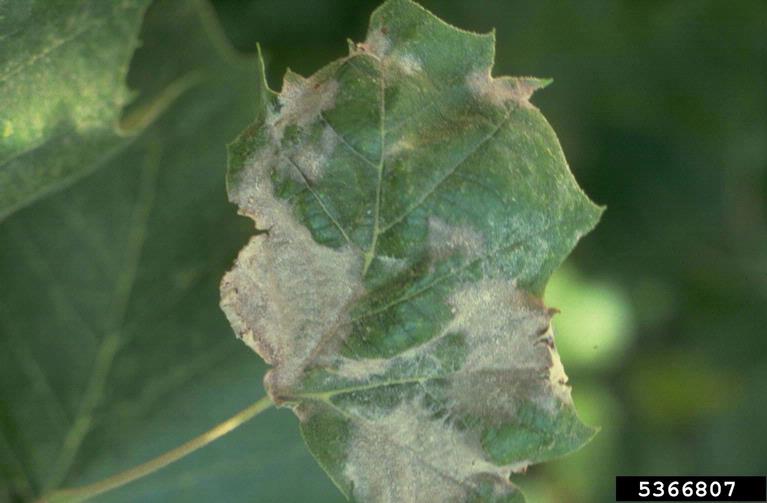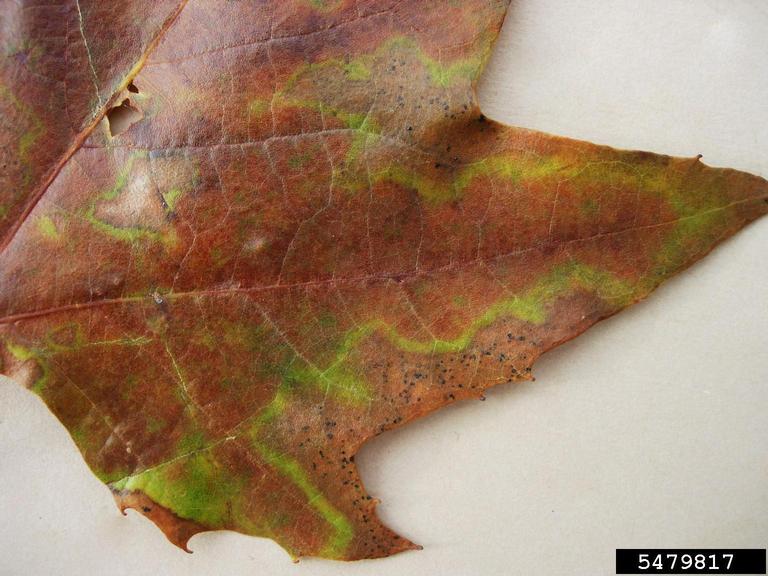
Photo credit: William Jacobi, Colorado State University, Bugwood.org
Sycamore anthracnose is a fungal disease that affects sycamore trees in spring, especially during wet and cool weather conditions. The symptoms include brown blotches on leaves, twig and shoot dieback, and overall tree decline. If your sycamore is exhibiting these symptoms, it’s important to prevent the spread of the disease by pruning infected branches and removing fallen leaves. As always, prevention is the best strategy. If you have a sycamore tree on your property that you would like to keep healthy, we recommend our preventative treatment which protects the tree for up to 3 years.
Get a QuotePowdery Mildew
Powdery mildew is a fungal disease that affects the foliage of many trees, including sycamores. This disease is easy to identify because it looks just the way it sounds. The most common symptom is a white powdery substance on the leaves. Eventually, this disease causes leaves to curl and turn yellow. Luckily, powdery mildew is more of a cosmetic problem than a significant threat to the a healthy mature sycamore tree’s health. To prevent the spread of the disease to other trees, remove and discard affected leaves.
Bacterial Leaf Scorch (BLS)

Photo credit: Elizabeth Bush, Virginia Polytechnic Institute and State University, Bugwood.org
Bacterial leaf scorch is a disease caused by a bacterium that affects a wide range of trees, including sycamores. Symptoms include yellowing and browning of leaf margins, which gradually spreads towards the center of the leaves. The disease is fatal if left untreated. We offer an antibiotic treatment that can help combat this issue if your sycamore has been infected. However, the best remedy is to keep your sycamore tree healthy; a stressed tree is much more likely to succumb to diseases.
Canker Stain
Canker stain is a fungal disease that attacks the tree’s bark, causing it to discolor and ooze, and eventually leading to the tree’s death. Sycamore trees that are stressed or have existing wounds are more susceptible to the disease. This disease has no cure and is highly contagious. To prevent the spread of canker stain to other trees, all tree debris should be disposed of appropriately. To help prevent this disease from infecting your trees, hire a qualified tree care company like RTEC Treecare to prune your sycamores properly to avoid wounds that will not heal and provide an entry point for fungal spores.
Sycamore trees are a valuable asset to any landscape, but their health can be negatively affected by common diseases. Luckily, you have us as your partner on your property and we can identify and treat these diseases to help you maintain the beauty and longevity of your sycamore trees. Early detection and prompt treatment can mean the difference between healthy and dying trees. As always, meeting with a certified arborist is recommended to determine the best course of action.


